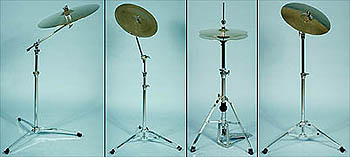
| Opus 22 - Cymbals |
|
|
Around 1620 in Constantinople, it appears a process was discovered to produce a robust alloy of copper and tin, which made it possible to create a thin, highly resonant disc. The process was handed down from generation to generation in the Zildjian family, whose name means "cymbal maker." In the late 1920s, some of the family immigrated to the United States, where the encounter between centuries-old expertise and dynamic new music inevitably affected the cymbal's development. As a result, a wide array of cymbals appeared. Nowadays, a drum set can include up to a dozen different cymbals. The heir of this know-how is the Sabian foundry, where top-of-the-line cymbals are still hammered out by hand, using an age-old technique. The master cymbal maker, Robert Zildjian, is a direct descendant of the family. Sabian Ltd 
Sabian Ltd Meductic, New Brunswick 1991 Since 1981, the Meductic, New Brunswick, foundry has carried the Sabian name, which is actually an acronym made up of the initial letters of the first names of Robert Zildjian's three children. Robert Zildjian is the owner and president, and a descendant of the Armenian Zildjian family which, for generations, handed down the secret of the alloy used to make cymbals. Robert's father, Avedis, and his great-uncle Aram immigrated to the United States at the turn of the century. In 1968, when asked to establish a new branch of the American firm, Robert Zildjian settled in Meductic, a small town he had grown to like after fishing there several times. In 1979, Robert and his brother Armand divided up the company, and Robert became the owner of the Canadian branch. Combining acoustic research and specialized technology with ancestral know-how, Sabian has become a flourishing concern with an international reputation. Its cymbals are exported to all parts of the world. |
 |


